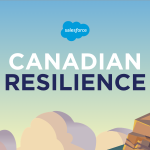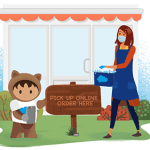In a crisis, the traditional ways of doing business don’t always work. And just a month into the COVID-19 pandemic, retailers are already experiencing disruptions. According to a recent survey, 42% of Canadian small businesses are worried about having to close permanently as a result of the novel Coronavirus. A quarter weren’t sure if they could survive another month under the current conditions.
As consumers continue to self-isolate and go all-digital, companies have new opportunities to connect with customers and reimagine their business models. Regardless of your organization’s size, location, or industry, this crisis offers the opportunity for innovation.
Let’s take a look at best practices for pivoting your retail experiences to digital — and how brands are already tackling traffic challenges head-on.
1. Offer flexibility in payment, loyalty, and delivery options
As the new norm of social distancing sets in, we’re beginning to see the economic effects of this pandemic. Experts predict real global GDP could contract as much as 1% around the world, and all avenues of business will feel the pinch. As a result, consumers will likely need new and innovative ways to pay for purchases.
Companies can help by multiplying loyalty offerings, issuing gift card expiration extensions, and rolling out longer payment cycles. For instance, Canadian car companies including Fiat Chrysler Automobiles Canada, Nissan Canada and Mitsubishi are debuting loan relief, payment rescheduling and in some cases 90-day payment deferrals during the pandemic.
If payment flexibility isn’t an option, here are other ways to offer relief:
-
Give customers additional payment and shipping options, like the one Canada Post introduced to receive parcels that do not require signatures or contact upon delivery, or Mastercard’s decision to increase contactless payment limits across Canada.
-
Follow companies like Swiss Chalet’s lead and connect commerce and service so customers can place orders by phone as well as online and arrange for contactless delivery. This is especially relevant for consumers who may want to discuss purchases before buying but are unable to go into a store.
-
Offer emergency services like eSupply Canada. The company is supporting Canada’s Indigenous community by providing office supplies at cost to anyone who has to work from home due to the pandemic.
2. Create new digital and social media experiences
Now with an all-digital customer base, retailers can no longer rely on tried-and-true physical experiences. This is the time to use your entire workforce to think in new ways about connecting with customers.
For example, Toys R’ Us Canada developed an initiative called ‘Stay-at-Home Play” which included ideas for kids to have fun via YouTube videos, a ‘Wash Your Hands Challenge” that featured a dance-and-scrub-along song on TikTok and play packs that could be ordered online.
Here are three other ways to engage beyond your four walls:
-
Extend your retail staff’s expertise on social media. Edmonton specialty flower shop Cory Christopher has already held a ‘virtual flower party” live on Instagram and is developing a service where customers can have a kit delivered to their home with supplies, then participate in online flower-arranging workshops.
-
Offer a unique service. Shoppers Drug Mart’s physical locations are still open but it has extended the value it provides customers by partnering with SilverCloud Health to deliver a virtual stress management program on any mobile device for those whose mental wellness has been affected by COVID-19.
-
Create 1:1 experiences using video. One example we love: Canada’s Wonderland, which might not open in May as planned, is already helping those wishing they could enjoy the theme park by offering 30 different virtual roller coaster rides.
3. Use your best assets to contribute to the greater good
According to Forbes, 88% of shoppers believe brands have the power to make the world better. And now more than ever, we have an opportunity to do good in our communities. Whether that’s making charitable donations, supporting employees and customers in need, or stepping up with more sustainable practices, customers are looking at their favorite brands to do what’s right.
Beyond monetary donations, companies are using their pre-COVID assets to assist during the pandemic. Here are three examples of how companies are contributing more than money right now:
-
Use specialized technologies for charity. Corby Spirit & Wine, Top Shelf, Dillons and other distilleries are now making hand sanitizer.
-
Use marketing dollars as a force for public good. Fast-food chain Mary Brown’s Chicken & Taters recognized the need to make news more accessible to all Canadians by paying newspapers to take down their paywalls.
-
Repurpose factories, warehouses, and distribution centers. For example, luxury apparel maker Canada Goose is using its facilities to manufacture scrubs and patient gowns, and Quebec hockey equipment firm Bauer is creating face shields for medical professionals.
In this unprecedented time, much is unknown — and things change quickly. But retailers all over the world have already stepped up to meet these trying times.
Through it all, the ones who weather this challenge will be the ones who stay closest to their customers.





















